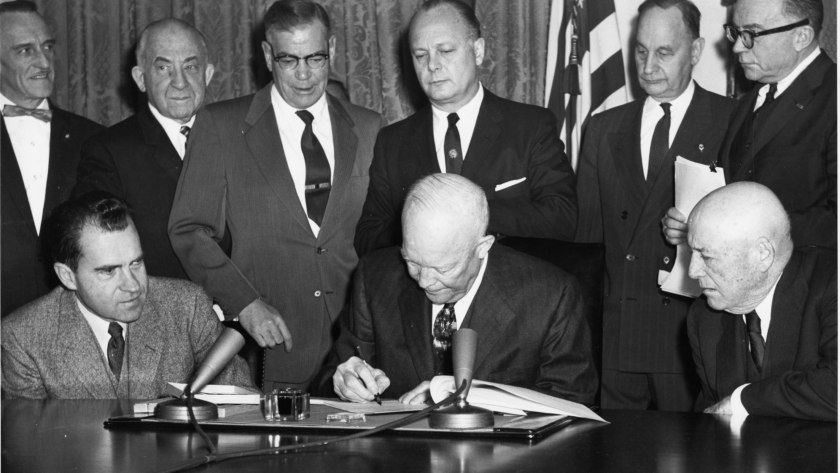The purchase of Alaska in 1867 ended the Russian effort to expand to North America, eventually leading this area to statehood.
Alaska is one of the most unique areas that has become a state and was the first detached from the lower 48donned with this honor. While the purchase of the area took place shortly after the Civil War was over, it wasn’t until nearly 100 years later that this area was granted statehood. The purchase of this area certainly slowed the competition Americans had with Russian explorers but did not create a landmass that would be a state for many years.
What Was Alaska Before Being a State?
Today, we still have some areas that are owned by the United States that are called territories. This was the case for the Louisiana Purchase, Oregon Country, and Alaska. Even Hawaii was at one time a territory when it ceded itself into the United States. This meant that different rules were in effect for the area than those that are in place for a state. This would be an area that had a governor appointed by the President of the United States and not elected by the population of the area.
What’s Needed for a Territory to Become a State?
Before a territory can become a state, it has to first prove that the area has a large enough population to sustain itself economically. Without this proof, the areas are in a status that doesn’t allow people to govern themselves, which is what territories face. At first, these territories have no representatives in Congress, but when authorized by Congress, a two-house legislature is created to allow the territory to make laws for itself. Unfortunately for the territory, Congress retains the authority to veto any laws created.
The territory system was established as a precaution in an area. Its nearly impossible to predict how a territory would grow and who would eventually move there and build their homes. Some people might head to ta territory, make money, and then head back to where they came from, never to venture to that area again. Being a territory might sound like causing an area to be a second-class region but proving economic stability and population growth allows Congress to realize the potential of an area before granting it statehood. With an area as remote as Alaska, this process took much longer than it did with some other territories.
The First Attempt by Alaska
The territory of Alaska first applied for statehood in 1916, in the middle of one of the largest wars in the world. The act for statehood was introduced by Judge James Wickersham, but the act did not pass. Many who voted against the act were under the impression that Alaska did not want to be a state but would rather be its own country, separate from the United States and from Russia. Unfortunately, this meant that this territory would not be granted statehood at that time.
Resentment Sets In
By the end of World War II, the residents of Alaska were becoming resentful of the second-class status of their territory. The area had grown, the population met the requirements, and the economy of the area was on the rise. Some had become resentful of the bureaucratic approach that Congress applied to Alaska that would not fit the rugged terrain of the area. Many felt that statehood would allow them to grow the population and economy as Alaska could create laws that would fit their area rather than being governed from afar.
Measures Were Put in Place
Even in 1959 when Alaska was finally granted statehood, Congress did not feel that a population of barely over 225,000 people could generate enough tax dollars to pay for state government. To aid this situation, two measures were put in place to pay for the new state.
The first measure set aside sixty percent of the land in Alaska, 225 million acres, as Federal land. This land would be mined for minerals, with ninety percent of the profits from sales of these minerals going to the state of Alaska. Because oil is one of the most plentiful and important minerals in the area, the revenue from oil sales in the federal land still goes to Alaska at a rate of ninety percent of the profits.
The second measure was for Alaska to select 104 million acres of the remaining land that was unreserved and unoccupied to be it’s own. The title of this land was transferred from the federal government to the state to allow the state to receive money from this land as they made it more economically valuable. This land could be used for development or settlement and support many of the functions of the state.
A Constitution Was Written
To this day, the constitution that was written in Fairbanks, Alaska, in the winter of 1955-1956 is considered one of the best state constitutions ever created. There would be 55 delegates that were dedicated to planning the future of this new state and would focus on protecting the citizens of the area while creating a state government that fit this new area. As the most northern state in the country, with the most rugged terrain, the laws would need to be a bit different for Alaska to enjoy the benefits of statehood.
The Fireworks Began
Parades and fireworks began on June 30, 1958, six months before Alaska would officially receive statehood. This celebration marked the date when the bill allowing this territory to become a state had finally passed both houses of Congress. Another celebration took place on January 3, 1959, when President Dwight D. Eisenhower signed the bill, and Alaska was officially the 49thstate in the union. This marked the first state to be physically separated from the others in the country and a battle for statehood that dated back more than forty years for the people of this incredible area of the country.
This post may contain affiliate links. Meaning a commission is given should you decide to make a purchase through these links, at no cost to you. All products shown are researched and tested to give an accurate review for you.




